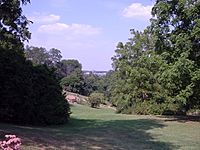Nichols Arboretum facts for kids

The Nichols Arboretum, with the UM North Campus in the distance.
|
|
| Established | 1907 |
|---|---|
| Location | 1610 Washington Heights, Ann Arbor, Michigan 48104 |
| Type | Arboretum and Botanical Gardens |
| Collection size | Peony Collection, Heathdale Collection, Centennial Shrub Collection, Dow Prairie |
| Owner | University of Michigan |
The Nichols Arboretum, often called the Arb, is a special outdoor space in Ann Arbor, Michigan. It's like a big park with lots of different trees and plants. The University of Michigan takes care of it.
The Arb is about 123 acres big. That's almost 50 hectares! It's located on the eastern side of the university's campus. You can visit the Arb every day from sunrise to sunset, and it's free to enter. Part of the Arb is separated by the Huron River.
Contents
Discovering the Arb's History and Design
The Nichols Arboretum was planned in 1906 by a designer named O. C. Simonds. He used the natural hills and valleys of the land to create areas for both plant collections and wild spaces. Many of the older plants you see today were put in during the 1920s and 1930s.
The Arb is famous for a few special collections. These include its amazing Peony Collection and the Heathdale Collection. The Heathdale Collection has plants mostly from the Appalachian Mountains. There's also the Centennial Shrub Collection and the Dow Prairie. The University of Michigan even does controlled burns in the prairie each year. This helps keep the native plants and habitats healthy.
Fun Activities at the Arb
The Arb is a very popular place for students and visitors. People come here for many outdoor activities. You can go jogging on the trails or enjoy a picnic with friends. It's also a great spot to relax in the sun.
Maps are posted around the Arb to help you find your way. They show you how long the trails are and what kind of path they are (like gravel or stairs). When winter comes, some students even go sledding down the hills! They sometimes use cafeteria trays from the university dining halls for a fun ride.
In the summer, the Arb hosts "Shakespeare in the Arb". This is where actors perform Shakespearean plays outdoors. Imagine watching a play like A Midsummer Night's Dream or The Merry Wives of Windsor surrounded by nature!
Exploring the Arb's Plant Collections
The Nichols Arboretum is home to many different kinds of trees and plants. Here are some of the interesting groups you can find:
General Tree Collections
- Cedars of Lebanon: There are four of these special trees, planted in 1946. They are growing at the very edge of where they can survive in the cold.
- Chinese Fringetree: This tree is thought to be the oldest of its kind in Michigan.
- Ginkgo: Some of the oldest ginkgo trees were planted before 1920.
- Conifers: These are trees like pines, spruces, and firs. Many were planted between the 1910s and 1930s. You can see different types such as ponderosa pine and Engelman spruce.
- Larches: Look for Japanese larches planted in 1938 and European larches from 1952.
- Legume Trees: This group includes trees like the Eastern redbud and the Kentucky coffeetree.
- Magnolias and Relatives: You can find beautiful Fraser magnolias and tall tuliptrees here.
- Maples, Horse Chestnuts, and Buckeyes: These trees were planted in the 1920s and 1930s. You might see Japanese maples and different kinds of horse chestnuts.
- Oaks: The Arb has many native oak trees, like red, white, and black oaks. There are also some Asian oaks.
- Ulmaceae: This family includes American elms and Japanese zelkovas.
- White Pines: About 150 eastern white pines were planted in 1952. They add to the older, taller pines already in the Arb.
Other Special Plant Areas
- Centennial Shrub Collection: This area has popular shrubs and small trees. You can see crab apple trees, hawthorn trees, and a collection of lilacs.
- Dow Prairie: This 36-acre prairie has been brought back to how it looked before European settlers arrived. It's full of native prairie grasses and wildflowers.
- Gateway Garden: This is an entry garden that looks like an American meadow. It has pools and a dry creek.
- Heathdale: This section features plants from the Appalachian Mountains. You'll find different kinds of rhododendrons, azaleas, and mountain laurel. Some of these plants were collected on special trips in the 1920s.
- Peony Garden: This garden is truly amazing! It has 516 different kinds of peony flowers in 27 beds. Some of these plantings date back to 1927. It's the biggest public collection of old peony types in North America.
Natural Habitats at the Arb
The Arb also protects important natural areas where plants and animals live in their wild habitats.
Uplands
This area is mostly an oak-hickory forest. The oldest oak trees are between 75 and 119 years old! The oldest hickory trees are even older, from 109 to 135 years old. You can find red, black, and white oaks here. Other trees include white ash, basswood, and black walnut. Smaller plants like flowering dogwood and witch-hazel grow underneath the taller trees.
Wetlands
The wetlands area has plants that love wet soil. You'll find wet meadows and hardwood swamps. Trees like American elm, red ash, and silver maple grow well in these damp conditions.




